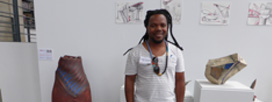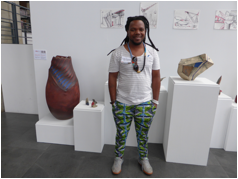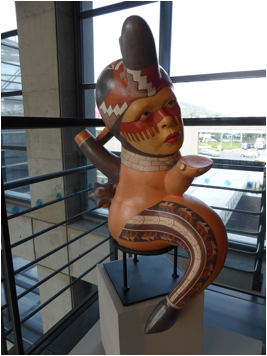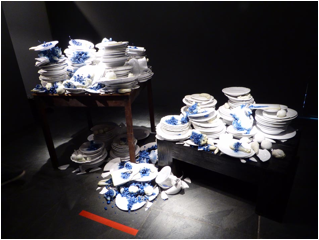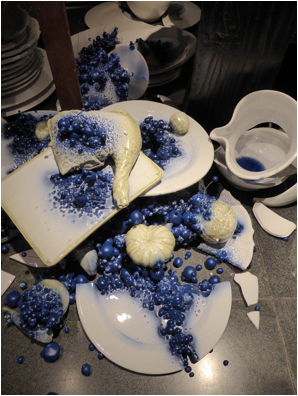Interpreting Ceramics | issue 16 | 2015 Articles, Reviews & Reports |
|
|||||||
|
Report by Moira Vincentelli Terra-Nova, Taiwan Ceramics Biennale, 2014 New Taipei City Yingge Ceramics Museum |
|
|||||||
|
Taipei County Yingge Ceramics Museum opened in 2000 and has established itself as one of the big players among the grand projects of the early twenty-first century. It holds major contemporary ceramic exhibitions alternating between a biennale organised by a competitively selected international curator and a more straightforward juried exhibition. The museum, an opulent monument of glass and steel, is set in a public park appointed with ceramic sculptures and installations, work sheds and large kiln sites and nine studios for artists in residence. The museum astutely builds up its contemporary ceramic collection acquiring works through the exhibition and residency programme. In 2014 there were artists from Italy, Romania, South Africa and UK. The international residency is increasingly available as a model for artists to maintain their practice but escape from some of the pressures of work at their home base – especially teaching. ‘Getting away from it all’ allows artists to focus, experiment and perhaps take risks. Residencies also encourage more serendipitous meetings between artists of different cultures and persuasions. Artist in residence and exhibitor, Andile Dyalvane, a South African artist who hand builds his large vessels was excited by the speed of a Taiwanese potter who could throw a large vessel for him to use for his signature surface decoration often based on face scarification patterns. The 2014 biennial curator competition was won by Wendy Gers and announced in September 2013. In the short space between then and the opening in May 2014 she developed the show which took on a challenging remit based on four topical themes: Glocal Identities; Shattered, Up-cycled and Recycled; 3d Printing and Digital Materialities. As a South African living in France, Gers challenged conventions of so-called contemporary ceramics by including in the exhibition work by Zulu potters and demonstrating how the iconic beer pot has been transformed into gallery art by South African makers, both black and white, Zulu and non-Zulu. The exhibition took over most of the museum, however one floor retained the permanent collection of the history of ceramics in Taiwan but with an exciting intervention. The provocative self-portraits based on pre-columbian prototypes of Kukule Velarde’s (Peru/USA) Plunder me Baby series, were placed in unexpected places in the permanent display. Witty but with a deeply serious underpinning in post-colonial discourse and identity, Velarde talks movingly about colonial oppression and her own position as a Peruvian living in the USA. Some of the most exciting work was in the Shattered/Upcyled section, most notably with Bouke de Vries’ (Netherlands/UK) magnificent installation War and Pieces originally designed for the eighteenth century interior of the Holburne Museum in Bath but for this show installed on a great table of darkened water which set off the re-cycled blanc de chine figurines to stunning effect. Also using water, but this time to address issues of ephemerality, the Korean artist, Kim Ju-ree, created carefully constructed replicas of Korean brick-built houses which gradually deconstruct as the clay dissolves. They can be read as a metaphor for a disappearing townscape caused largely by the booming capitalism of contemporary Korea. Pip McManus (Australia) used the potential of clay to dissolve in water in her evocative video piece ‘Night Vessel’ in which the clay figure gradually collapses against the more solid but simple iconic curve of the vessel. Italians were strongly represented in the Digital Materialities section. In Pierluigi Pompei’s sound piece giant ceramic horns emitted gentle sounds or whispers as viewers moved around in a darkened room. Francesco Ardini’s installation of piles of white dishes suggesting the remains of a great feast are overwhelmed by synthetic blue excretions like a rampant spreading virus. Based on the theme of Circe, his pieces seemed intellectually overly complex but undoubtedly powerful in their visual impact and, in some of the pieces, inventive in the use of new technology. Over the first weekend after the opening an international conference brought together artists and speakers. The conference was in English and Chinese and was a fine opportunity for discussion and debate with presentations from Wendy Gers, artists in the exhibition, and some invited curators and academics. The writer and curator, Kevin Murray (Australia) gave a thoughtful talk musing on the irony of the modern desire to throw over the past and tradition yet, at the same time, preserve it in museums and now, with new technology, to retain it in the ‘great digital empires of the cloud such as Google and Facebook’. It was an apt and challenging observation. Top of the page | Download Word document | Next |
||||||||
Report by Moira Vincentelli • Issue 16 |
